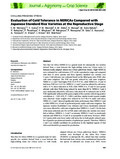| dc.description.abstract | New Rice for Africa (NERICA) is a general name for interspecific rice varieties derived from a cross between the high-yielding Asian rice (Oryza sativa L.) between locally adapted African rice (Oryza glaberrima Steud.). Eight NERICAs
were evaluated for cold tolerance (CT) at the reproductive stage and compared with their O. sativa parents and three Japanese standard rice varieties over 3 years. Cold tolerance was evaluated based on the filled grain ratio (FGR) after cold water irrigation. The FGR was greatly reduced by cold water irrigation. NERICA 1, 2 and 7 had higher FGR (51.9–57.9 %), while NERICA 6, 15 and 16 had lower FGR (6.2–14.5 %). NERICA 1, 2 and 7 were less affected by cold stress,
with a 31 % mean reduction in FGR, while NERICA 6, 15 and 16 were greatly affected, with their FGRs being reduced by more than 80 %. NERICA 3 and 4 were moderately affected by cold stress, with about 45 % reduction rate in FGR.
FGR significantly influenced the grain weights of the varieties with strong positive correlations (r=0.83–0.91; P<0.001), and thus, similar trends in grain weights were observed. Grain weights were reduced by 61.7–96.4 % under cold stress.NERICA 1, 2 and 7 showed significantly better performance than NERICA 3 and 4, while NERICA 6, 15 and 16 performed poorlyunder cold water irrigation. The Japanese varieties Koshihikari (very tolerant) and Ozora (moderately tolerant)
were more affected by cold water irrigation than NERICA 1, 2 and 7. On the basis of the mean reduction rate (%) in FGR under cold stress, the varieties were classi-fied as follows: NERICA 1, 2 and 7 as tolerant; NERICA 3 and 4 as moderately
tolerant; and NERICA 6, 15 and 16 as susceptible to cold stress. However, NERI-CA 7 grain yields were lower under cold stress due to both greatly reduced num-ber of panicles per plant and number of spikelets per panicle. Therefore, NERICA
1 and 2 are suitable candidates for production in the highland regions of East Africa and should be promoted for production. | en_US |

